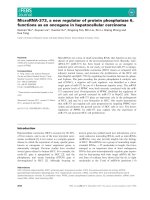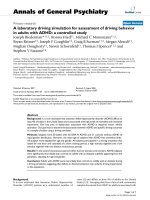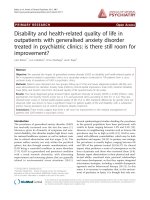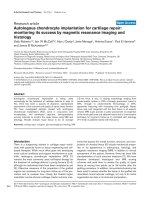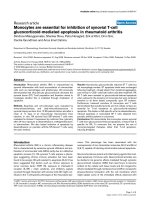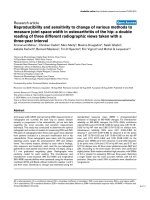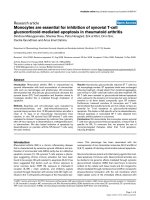Báo cáo y học: "Is it time for implementation of tight glycaemia control by intensive insulin therapy in every ICU" pdf
Bạn đang xem bản rút gọn của tài liệu. Xem và tải ngay bản đầy đủ của tài liệu tại đây (33.56 KB, 2 trang )
Page 1 of 2
(page number not for citation purposes)
ICU = intensive care unit; IIT = intensive insulin therapy.
Available online />Abstract
The second study on tight glycaemia control by intensive insulin
therapy (IIT) confirmed in medical intensive care unit patients the
decrease in hospital mortality reported by the same team in the first
IIT trial in surgical patients. However, methodological concerns, the
high rate of hypoglycaemia in spite of the infusion of large doses of
parenteral glucose and the frequent use of steroids presently
preclude considering these results as recommendations in other
intensive care units, but rather argue for the need for large-scale
assessment of the IIT approach by multi-centre studies to confirm
the efficacy and safety of this therapeutic modality.
In a recent issue of the New England Journal of Medicine,
Greet Van den Berghe and co-workers [1] published a
confirmation of the life-saving effects of tight glycaemia
control by intensive insulin therapy (IIT) in medical intensive
care unit (ICU) patients. This second study intended to
answer some of the questions and criticisms raised by the
landmark Leuven study of 2001, which reported a 4%
decrease in mortality in a surgical ICU population [2-7].
Hopefully, these questions will be answered by the multi-
centre assessments of the effects of IIT, the NICE-SUGAR
and GLUCONTROL trials, currently underway in Australia
and Europe, respectively [8]. Before the completion of these
two indispensable studies, Greet Van den Berghe and
colleagues wanted to confirm the life-saving effects of IIT in
medical ICU patients in order to answer specific criticisms
related to the type of patients, mostly surgical with two-thirds
being post-cardiac surgery patients, in the first Leuven study
[2]. Indeed, patients with myocardial ischaemia could
particularly benefit from a combination of a high amount of
glucose and insulin, as reviewed recently [9]. Interestingly,
Krinsley [10] reported a similar reduction in mortality in a
mixed population of medical and surgical ICU patients.
Greet Van den Berghe and colleagues succeeded but, as in
most major contributions, their study raised more questions,
which further argue for the importance of multi-centre trials
[3,7]. Our concerns regarding the second Leuven study [1]
follow.
Strictly speaking, this study cannot be considered to be
positive, as the long-stayers in whom a survival benefit was
found were actually not randomised. The sample of long-
stayer patients (n = 767) was smaller than the calculated
sample size of 1,200 patients that was required to test the
working hypothesis (a 7% reduction of the absolute risk of
death) with an alpha level of less than 0.05 and a beta level of
0.2. In the entire set of patients, the intent-to-treat analysis
indicated that there was actually no benefit related to IIT.
Moreover, mortality in the patients in whom the stay was
shorter than anticipated (less than 3 days) was higher in the
IIT group (26.8%; 56/209) than in the conventional treatment
group (18.8%; 42/224). This increase was found to be
significant when analysed by the chi square test, but not by
uncorrected proportional-hazards analysis, even after
correcting for the difference in baseline risk factors.
Compared to the first Leuven study [2], some of the recorded
secondary end points that could be considered as surrogate
markers of severity (ICU and 28-day mortality, requirement for
dialysis, incidence of bacteraemia, requirement for prolonged
antibiotic therapy, incidence of hyperbilirubinaemia and ‘hyper-
inflammation’) were not influenced as hospital mortality was.
As already underlined [7], the mortality rate of the medical
patients was high. Other local factors could also have
influenced the results, thereby questioning the applicability
of the findings to patients managed in other ICUs. The mean
amount of parenteral glucose infused (a mean of more than
220 g/day in long-stayers) was probably higher than in most
other ICUs, and parenteral steroids were used in more than
half of the patients. Unequivocally, these two factors reduce
the risk of hypoglycaemia and the duration of episodes of
hypoglycaemia, a major side effect of IIT. Nonetheless, the
Commentary
Is it time for implementation of tight glycaemia control by
intensive insulin therapy in every ICU?
Philippe Devos and Jean-Charles Preiser
Department of General Intensive Care, University Hospital Centre, University of Liege, Domaine universitaire du Sart-Tilman, B-4000 Liege, Belgium
Corresponding author: Jean-Charles Preiser,
Published: 21 March 2006 Critical Care 2006, 10:130 (doi:10.1186/cc4871)
This article is online at />© 2006 BioMed Central Ltd
Page 2 of 2
(page number not for citation purposes)
Critical Care Vol 10 No 2 Devos and Preiser
risk of hypoglycaemia was substantial, with 25.1% of the
patients in the IIT group experiencing a blood glucose level
below 2.2 mmol/l (40 mg/dl) at least once, compared to only
3.9% in the conventional group. The safety monitoring board
of the German multi-centre study VISEP considered a similar
increase in the incidence of hypoglycaemia important
enough to stop this trial [11]. The mortality among these
patients was higher than in the entire set. Clearly, the safety
of IIT needs to be assessed in patients with significant risk of
hypoglycaemia [12].
The target ranges of glycaemia were 4.4 to 6.1 mmol/l (80 to
110 mg/dl) and 10 to 11 mmol/l (180 to 200 mg/dl), implying
that there was no assessment of an intermediary blood
glucose value, which is often used [13]. Greet Van den
Berghe and colleagues already answered this question by
analysing the data of the first study and concluded that there
was a dose-response effect, with the largest improvement
found in patients with the lowest blood glucose level [14].
This hypothesis was found retrospectively, however, and
clearly requires confirmation from prospective trials.
The use of IIT in Leuven is probably easier than in other
institutions with a lower nurse-to-patient ratio. For an IIT
approach, the accuracy of capillary samples from some of the
patients is also questionable [15].
Lastly, insulin exerts many effects other than a decrease in
blood glucose [16], which could possibly be beneficial or
deleterious in different subsets of patients; these effects can
not easily be assessed and monitored in the presently
available trials.
In summary, questions about the efficiency and safety of IIT in
different ICUs around the world are far from answered and
much work has still to be done to answer the new questions
raised by the second Leuven study.
Competing interests
The authors declare that they have no competing interests.
References
1. Van den Berghe G, Wilmer A, Hermans G, Meersseman W,
Wouters PJ, Milants I, Van Wijngaerden E, Bobbaers H, Bouillon
R: Intensive insulin therapy in the medical ICU. N Engl J Med
2006, 354:449-461.
2. Van den Berghe G, Wouters P, Weekers F, Verwaest C, Bruyn-
inckx F, Schetz M, Vlasselaers D, Ferdinande P, Lauwers P, Bouil-
lon R: Intensive insulin therapy in the critically ill patients. N
Engl J Med 2001, 345:1359-1367.
3. Angus DC, Abraham E: Intensive insulin therapy in critical
illness. Am J Respir Crit Care Med 2005, 172:1358-1359.
4. Preiser JC, Devos P, Van den Berghe G: Tight control of gly-
caemia in critically ill patients. Curr Opin Clin Nutr Metab Care
2002, 5:533-537.
5. Devos P, Preiser JC: Tight blood glucose control: a recommen-
dation applicable to any critically ill patients? Crit Care 2004,
8:427-429.
6. McMahon MM, Miles JM: Glycemic control and nutrition in the
intensive care unit. Curr Opin Clin Nutr Metab Care 2006, 9:
120-123.
7. Malhotra A: Intensive insulin in intensive care. N Engl J Med
2006, 354:516-520.
8. Clinicaltrials.gov []
9. Devos P, Chioléro R, Van den Berghe G, Preiser JC: Glucose,
insulin and myocardial ischaemia. Curr Opin Clin Nutr Metab
Care 2006, 9:131-139.
10. Krinsley JS: Effect of an intensive glucose management proto-
col on the mortality of critically ill adult patients. Mayo Clin
Proc 2004, 79:992-1000.
11. Brunkhorst FM, Kuhnt E, Engel C, Meier-Hellmann A, Ragaller M,
Quintel M, Weiler N, Gründling M, Oppert M, Deufel T, et al.:
Intensive insulin therapy in patient with severe sepsis and
septic shock is associated with an increased rate of hypo-
glycemia: results from a randomized multicentre study
(VISEP) [abstract]. Infection 2005, 33:s105.
12. Vriesendorp TM, van Santen S, De Vries JH, de Jonge E,
Rosendaal FR, Schultz MJ, Hoekstra JB: Predisposing factors
for hypoglycemia in the intensive care unit. Crit Care Med
2006, 34:96-101.
13. Devos P, Ledoux D, Preiser JC: Current practice of glycaemia
control in european intensive care units (ICUS) [abstract].
Intensive Care Med 2005, 31:S786.
14. Van den Berghe G, Wouters PJ, Bouillon R, Weekers F, Verwaest
C, Schetz M, Vlasselaers D, Ferdinande P, Lauwers P: Outcome
benefit of intensive insulin therapy in the critically ill: insulin
dose versus glycemic control. Crit Care Med 2003, 31:359-
366.
15. Kanji S, Buffie J, Hutton B, Bunting PS, Singh A, McDonald K,
Fergusson D, McIntyre LA, Hebert PC: Reliability of point-of-
care testing for glucose measurement in critically ill adults.
Crit Care Med 2005, 33:2778-2785.
16. Andreelli F, Jacquier D, Troy S: Molecular aspects of insulin
therapy in critically ill patients. Curr Opin Clin Nutr Metab Care
2006, 9:124-130.


